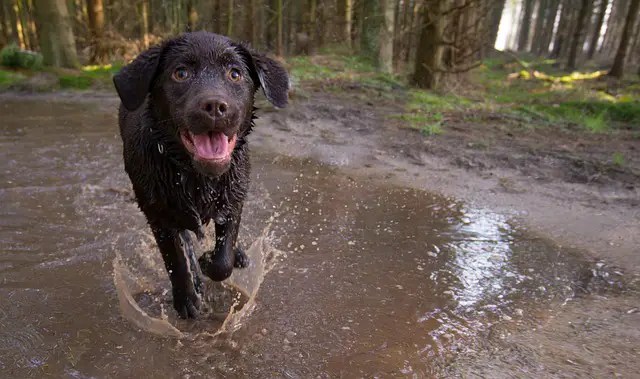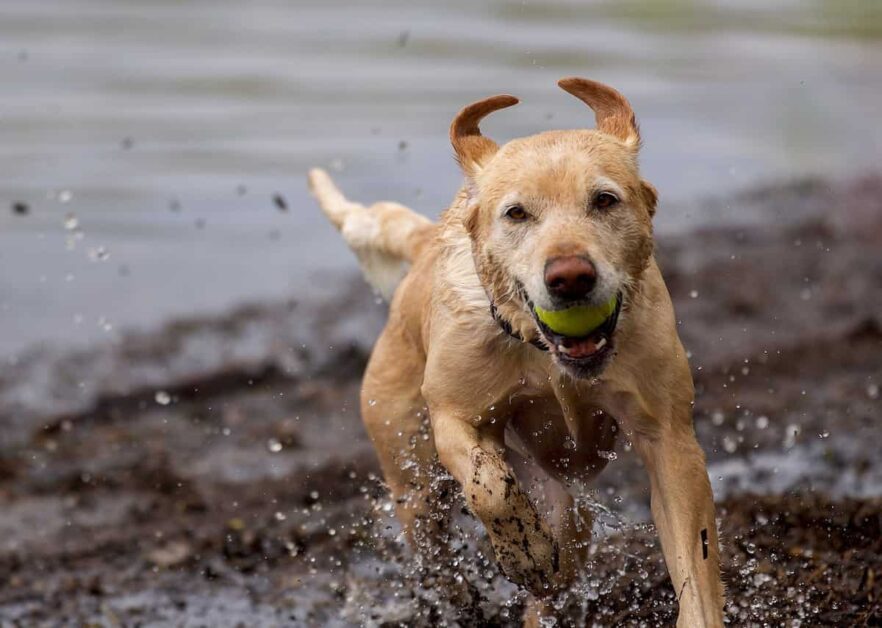Labrador Retrievers were originally bred as hunting dogs, making them a perfect running buddy. But have you ever wondered how fast a labrador can run? Labrador dogs run at a top speed of 20 to 30 miles per hour, with an average running speed of 14-18 mph.
This gun dog breed is a great canine friend suited for long-distance running. Similar working dogs include the german shepherd and golden retriever.
What factors does their pace depend on?
Healthy dog
A Labrador’s health plays a significant role in determining how fast it can run. Optimal health is crucial to achieving top performance. For instance, dogs with underlying health conditions like hip dysplasia may experience pain or discomfort when running.
Similarly, overweight Labradors will struggle to reach their maximum potential speed due to their extra weight. Regular veterinary checkups, proper nutrition, and portioned food intake help in long-distance runs. Monitor your dog for signs of stress or fatigue during physical activities. Pushing them too hard could lead to organ failure. Be careful.

Fitness Level
A Labrador’s running speed varies based on its fitness level. A well-conditioned Labrador Retriever can reach up to 35 miles per hour (56 km/h) in a sprint. An out-of-shape or overweight lab can manage half of that speed.
Training alongside your canine companion is an excellent way to stay motivated and promote overall health! Some Labs may have more natural athletic ability than others. As a dog owner, observe your labrador retriever’s capabilities and adjust exercise routines accordingly.
Extreme Weather Conditions
In hot weather, Labradors are prone to overheating and dehydration. Dog owners need to take necessary precautions when running in hot weather. Bring enough water, take frequent breaks in shaded areas, and avoid running during peak sun hours.
Watch out for your dog’s paws in extremely cold temperatures. Ice balls can form between their toes, causing pain and even frostbite. The snow-covered ground can hide sharp objects like broken glass which could cause injury. Hence, be vigilant while running during extreme weather conditions.
How Do You Train Labradors For Running?
To train Labradors for running, gradually increase the distance and intensity of their workouts, provide breaks, and monitor their food intake.
Labradors In Warm Weather
Labradors are resilient and adaptable but can still be affected by warm weather conditions. Here’s a table to help you understand how Labradors fare in warm weather.
| Temperature Range (°F) | Effects on Labradors | Precautions to Take |
|---|---|---|
| 70-75 | Comfortable running temperature for most Labradors. | Provide water and take breaks as needed. |
| 75-85 | Labradors may become tired sooner and may pant more. | Watch for signs of overheating, run during cooler parts of the day, and offer more water breaks. |
| 85-95 | Risk of overheating and heatstroke increases. | Limit running duration and intensity, seek shaded areas, and ensure adequate hydration. |
| 95+ | High risk of heat-related illness or injury. | Avoid running during the hottest parts of the day, consider indoor exercise alternatives or swimming for cooling off. |
Is a Labrador puppy Suitable For Running?
Puppies have developing bones and joints that need time to strengthen before they can handle the stress of running.
- They should avoid running until six months old, although larger breeds may need more time.
- A good rule of thumb is to wait until your puppy’s growth plates have closed before engaging in any exercise.
- Start small with short walks to build up your puppy’s fitness level. Overexerting can lead to joint damage.
- Pay attention to signs your labrador puppy needs a break, such as heavy panting or lagging on walks.
How Fast Can A Labrador Retriever Run Over Large Distances?
Most sources say the Labrador’s top speed is 35 miles per hour or 56 km/h. However, this speed is achieved during a sprint rather than a sustained run. On average, Labradors can run at speeds ranging from 14-18 mph, which makes them excellent long-distance runners. Weather and the dog’s age and health can impact the labrador’s stamina.

how fast do labs run When Older?
As labrador retrievers age, they slow down and have decreased energy levels. Senior dogs may not be able to run as fast or for long distances.
An adult Labrador Retriever can still run at around 10-12 mph even in their senior years. As dogs age, they are susceptible to arthritis or joint pain. Proper nutrition and regular check-ups can help keep your Lab healthy. If they seem tired or in pain, take a break or try less strenuous activities like walking or swimming.
Safety Tips While Running With A Labrador Retriever
Leashing
This is an essential safety measure you should never overlook. Ensure you securely attach the leash to your dog’s collar or harness before starting your run. This prevents them from running off into traffic or other dangerous areas. It helps you control your pet if they get too excited and start pulling ahead.
Choose the right type of leash for your Lab. A retractable leash is great for casual walks, but a standard 6-foot leash made of sturdy material like nylon or leather is better for running.
Stay Hydrated
Keep your Labrador hydrated while running. Here are some tips:
- Bring water: Always carry water for your Labrador when going out for a run.
- Choose the right time: Avoid running during midday. Opt for early morning or late evening runs instead.
- Watch for signs of thirst: Be alert for signs of thirst in your Labrador Retriever, such as panting, dry mouth, or lethargic behavior.
- Use hydrating treats: Bring hydrating treats to keep your Lab interested in drinking more water while on the run.
- Don’t overdo it: Ensure your dog isn’t overdrinking, as it causes bloating or vomiting.

Know When To Stop
It’s important to know when to stop. Even though they are athletic dogs and can run at impressive speeds, exhaustion or overheating can be a bummer. Heavy panting, drooling, or stumbling calls for a break. Extreme temperatures strain your dog’s health, so adjust your routine.
Health Check
Regularly check their health to keep them comfortable. Here are some tips for conducting a health check:
- Check their breathing: Ensure your Labrador is not excessively panting.
- Monitor hydration: Check how much water your dog drinks, and always provide access to fresh water.
- Watch for signs of fatigue: If your dog starts slowing down or appears tired, take a break and let them rest.
- Check their paws: Inspect your dog’s paws for any cuts or blisters that could cause discomfort.
- Look out for overheating: Excessive panting, drooling, or redness in the gums or ears is a sign.
Sprinting
Sprinting is an impressive feat for a Labrador. A fit Labrador can run around 35 miles per hour in their fastest sprint. These sprints are great for burning off excess energy. Not all Labradors can sprint at their top speed due to age, health issues, and fitness level. Overexertion can lead to injury or stress on joints and muscles.
Grooming them for and after runs
Grooming is essential to maintaining your Labrador’s health and keeping them in good shape for running.
- Brush their coat regularly to avoid matting and tangles hindering their movement.
- Trim their nails to prevent any injuries while running.
- Clean their ears and teeth regularly to prevent infections.
- Bathe your Labrador as needed, but don’t over-bathe.
- Check for fleas, ticks, and other parasites that can harm your dog’s health.
- Use a good quality shampoo formulated for dogs to keep their coat healthy and shiny.
Health Concerns That Can Affect How Fast Can A Lab Run
Health issues can affect your dog’s physical abilities and overall well-being. Here are five common health concerns:
- Hip Dysplasia: A common issue with Labradors, hip dysplasia occurs when the hip joint doesn’t develop properly, causing pain and limiting their running capability.
- Obesity: Labs are prone to weight gain. This can inhibit their running speed and strain their joints, causing health complications.
- Arthritis: As Labradors age, they may develop arthritis, resulting in reduced mobility and discomfort while running.
- Heartworm: A serious, potentially fatal condition, heartworms severely impact a Labrador’s ability to run by restricting blood flow and causing heart and lung damage.
- Exercise-Induced Collapse (EIC): A genetic condition in some Labradors, EIC can lead to weakness, disorientation, and even collapse during vigorous exercise or running.
how fast are labs Compared To Other Dog Breeds?
Labrador Retriever – Labs are medium to large-sized dogs that can run at speeds around 30 mph. They are athletic and energetic dogs originally bred to retrieve game during hunts. Their energetic nature makes them one of the fastest dog breeds.
- Greyhounds – Greyhounds are bred for racing and speed. They are lean and muscular dogs that can reach maximum speeds of 45 mph, making them one of the absolute fastest dog breeds.
- German Shepherd – German Shepherds are large, agile working dogs that have a top speed of around 30 mph. Their strength and stamina allow them to maintain fast speeds over moderate distances.
- Border Collie – Border Collies are energetic herding dogs with top speeds of around 30 mph. Like Labs, they have good endurance that allows them to run fast repeatedly when herding livestock.
- Jack Russell Terrier – Despite their short legs, Jack Russell Terriers are lively small dogs that can run up to 25 mph. They have lots of energy and high prey drive.
- Doberman Pinscher – Dobermans are large, muscular dogs originally bred as guard dogs. They can reach speeds of around 32 mph and have great endurance.
FAQs
At What Age Do Labs Calm Down?
Labradors reach maturity between 18-24 months of age. As they age, they become less hyper Most Labradors reach a calmer state and prefer relaxing indoors around 3 years of age.
How Fast Can Labs Sprint?
Labradors can run at a top speed of around 20 to 30 miles per hour. Same as a pit bull. They reach an incredible maximum sprinting speed of up to 35 miles per hour or 56 km/h.
Labrador retrievers have an average running speed of 14-18 mph – which is impressive considering they can keep this pace going for extended periods.
How Long Can A Lab Go Without Going To The Bathroom?
Puppies can hold their bladder for about one hour per month of age. So, a two-month-old lab puppy should be able to hold it for about two hours. Labradors, as adult dogs, can typically hold their bladder for six to eight hours. Always let your dog relieve itself before going for a run.
Frequent bathroom breaks may indicate urinary tract infections or gastrointestinal problems. Training your Labrador to go on command is helpful when planning runs or outdoor activities.
Can Labradors Be Left Alone For 8 Hours?
Leaving a Labrador alone for 8 hours is not wise. Leaving any dog unattended long-term can lead to destructive behaviors like barking or chewing on furniture or separation anxiety.
How Far Can A Labrador Run?
The distance a Labrador can run depends on age, fitness level, health status, and weather conditions. Adult Labradors can comfortably run 5 to 10 miles (8 to 16 km) at a moderate pace without any issues. Gradually build up your dog’s endurance with proper training and a balanced diet tailored for active dogs.
Author Profile
- Site Owner And Planning Specialist
-
Aritra, the founder of Labradorandyou.com, is a lifelong dog lover whose passion ignited for Labradors for their loyalty and intelligence. With extensive research and personal experiences, Aritra has become a Labrador expert, offering a rich resource on the breed. Labradorandyou.com provides reliable, timely, and evidence-based information, including Labrador-specific product reviews, training techniques, and care tips.
Labradorandyou.com was born out of Aritra's passion and his desire to share his profound knowledge about the breed. The site serves as a comprehensive resource, offering a wealth of up-to-date information for Labrador owners and enthusiasts alike
Also by the author
-
 FAQNovember 17, 2023How To Adopt An Emotional Support Dog?
FAQNovember 17, 2023How To Adopt An Emotional Support Dog?
-
 Mix-BreedsNovember 16, 2023Red Labradoodle Ultimate Guide: Breed Facts, Care Tips
Mix-BreedsNovember 16, 2023Red Labradoodle Ultimate Guide: Breed Facts, Care Tips
-
 Top BreedersNovember 8, 2023Breeding Labradors: Everything You Need to Know
Top BreedersNovember 8, 2023Breeding Labradors: Everything You Need to Know
-
 FAQOctober 17, 2023Do Dogs Like Music? Researchers Say Yes! Find Out
FAQOctober 17, 2023Do Dogs Like Music? Researchers Say Yes! Find Out





